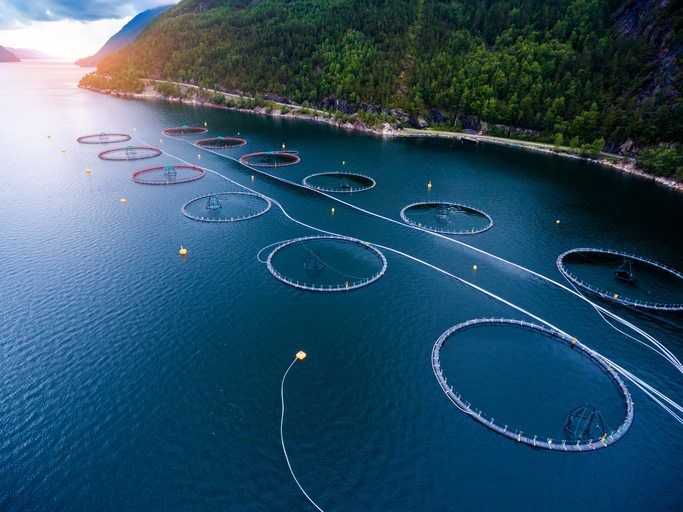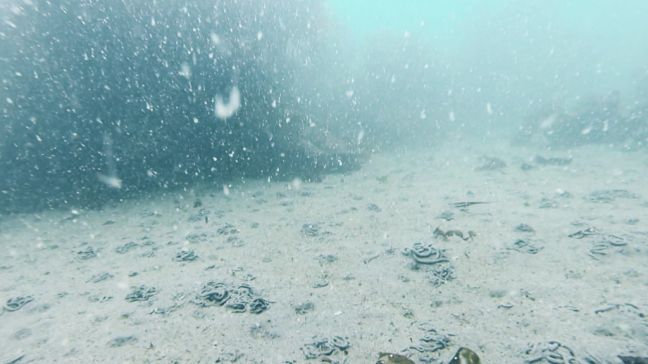Why you should start a business in aquaculture tech in 2022

“So what will your company do?” I’ve heard this question so many times last week, as I announced I quit my job at Sama to start a company. A fairly natural question. The truth is…I don’t know.
I always thought you needed an idea to start a business. But it turns out finding an idea is much easier than choosing an idea. Choosing an idea implies some criteria to be defined. I’ll assume therefore that any great business idea revolves around solving a problem for someone. That someone, hopefully, is a business (because I like B2B) who can pay for my solution, and isn't alone.
I will use this blog series to explore different ideas, in different industries. And today, we’re starting with Aquaculture. I hear you thinking cold water. Potentially green. Infrastructure, nets, metal, pipes. Humid. Not sexy. Yes, that was also my initial reaction.
But this feeling quickly cleared out as I was researching the topic and talking with people in the industry.
In the post below, I will look at what the potential could be, the numerous existing problems I can see, and the opportunities where I could spend a few years on to build a business. Maybe I can even manage to get you as excited as I have been about aquaculture!
1. It's a huge market and it's growing.
If you are not familiar with aquaculture, it is the farming of fish, shellfish and algae in all types of water environments. Although I love algae, I’m going to set it aside for the sake of this exercice. I might come back later to it in a different post. For now let's look at the demand of fish and seafood.
Worldwide demand for fish and seafood is already massive - Over 150 million tonnes today. And it is expected to double by 2050. As the consumer starts to care deeply about human health and sustainability, might even be greater than this forecast.
Why? Because meat has bad press and switching from meat to blue foods (defined as aquatic foods captured or cultivated) would enrich diets in micronutrients, including iron, calcium, vitamin B12, zinc, and seafood omega-3 fatty acids. More good reasons to see further growth in the future.
More importantly, aquaculture is on the rise and is supplying more fish than capture fisheries worldwide:
Let’s look at the potential of both aquaculture and capture fisheries to supply the expected growth.
2. Spoiler Alert: Capture fisheries won’t supply.
For the very most, fish stocks have already reached their limit to remain sustainable or are already overfished. Probably not news to you. This means that there is no room for doubling the production. In the diagram below, you can see 94% of the current fish stocks can’t be used to catch more fish than we do today without depleting fish populations.
Imagine that demand is rising and we can only rely on fish stocks. The demand can’t be supplied (or if we decide to overfish, only on the very short term). Fish prices will rise. Only the privileged will have access to it.
Another path is that we all become vegan, but the projections are not leaning this way. To sustain the expected market growth, production must come from aquaculture, and it’s already happening. Numbers of aquaculture farms have boomed over the past three decades in response to the growing demand.
3. There are real problems to be solved.

Yes, Aquaculture can ensure that 10 Billion people have all access to an affordable and regular supply of fish. But at what cost?
On the one hand, aquaculture has become more sustainable over the last past 20 years. But it is far from sufficient.
Aquaculture pollutes water through food left uneaten, fish feces, and dead fish. This is causing nutrient build-up around tanks. In turn, it contributes to the eutrophication of the waters. The fish get diseases. Disease or parasites from aquacultures can be transmitted to wild fish. Antibiotics meant for the fish impact the neighboring sea life. Overfishing of smaller fish to feed the bigger fish. Destruction of mangrove forests to build fish ponds. Fish are escaping regularly and pose threats for the species as a whole.
The great thing about those problems is there is an economic aspect attached to them. If the water is polluted, then the farmed fish gets sick. In response, the aquaculture farm needs to increase spending on freshwater if it runs on closed systems or otherwise spends more on antibiotics. Fish farmers need to operationally count on part of the harvest that will be lost to disease or damage.
Fish feed is also a high portion of the cost for an operation, somewhere between 50 to 70%. From my interviews, farmers are already cautious not to overfeed, but it is a complex problem to manage. They also don’t want the fish to starve. They are open to great alternative sources of feeding if that means healthy fish and higher profits.
Further, there are real opportunities to create short food supply chains. Connect those farmers to their customers.
Fish farmers are hungry for solutions that respect their privacy and independence. And there is so much that tech can do to tackle those challenges.
On the other hand, bivalves (oyster, mussels, scallops, clams) have a positive ecological footprint as they sequester carbon. Unlike farmed fish, they eat the excess algae and other organic particulates cleaning up the waterways and oceans. Bivalves help to protect watercourses from the effects of eutrophication.
Yet because they are feeder filters, they can also absorb harmful toxins. Usually coming from sewage or agricultural run-off. They are a luxury product, at least in the west, but they can be farmed cheaply.
Technology could be an enabler of (safe) bivalves' consumption and production.
4. Tech can be applied across the aquaculture value chain.
What concrete opportunities are there to build a business?
Here are a few: Fish and water monitoring. Measuring and dosing the right inputs. Automation. Farm management systems. Marketplaces connecting farms to their customer. Financing possibilities. Increasing transparency. There are a lot of opportunities to capitalize on.
In terms of actual technology, big data and AI are the sectors to watch. New technologies that rely on data aggregation and analytics can be applied across the aquaculture value chain.
As an example of what can be done, some of the major players already invest in a toolkit of technologies to create a systemic shift in the industry.
Xpert Sea combines smart aquaculture equipment with a farm management platform to uncover insights driven by artificial intelligence. They've also more recently added easy payment technology for greater transparency, communication and convenience.
eFishery builds technology solutions from smart feeding, cloud-based dashboard, and data platform to help the fish and shrimp farmers to grow their business sustainably.
Aquaconnect, one of the more recent player, offer data-driven farm advisory and marketplace solutions to Shrimp and Fish farmers.
5. Capital can be raised.
There are two ways to finance a business initially. Bootstrapping - growing the company from sales or growing the company initially with external capital. For any industry I am exploring, I always look at what investors and kind of capital are in-game. Well-financed startups are usually a great sign for the space.
The aquaculture sector received some attention already a few years ago. But since 2021, the space has gotten some serious traction.
Some notable deals closed are Xpertsea closing 20M in series B in August 2021 and eFishery closing respectively 15M in series B in August 2021 and 90M in series C in January 2022. With respectable investors such as Sequoia Capital, Temasek Holdings and Softbank Vision Fund.
Those amounts are well into Crunchbase's average for series B and C. That means there will be more VCs and more startups entering the space too.
Where to get from there
A growing market, real problems to solve, high impact, and with a renewed interest from investors, the aquaculture sector is hot! I got excited about the aquaculture industry. Why? Because fish and seafood bring a lot of health virtues. It tastes great. We can make it affordable for everyone. We can make it sustainable. We can make it ecological. And this could be done with a profitable business. But before making an informed choice, I'll investigate a few other industries.
But if you've been waiting for that idea...that perfect idea. Consider the aquaculture space and what tech can do here. There are tremendous opportunities for a successful startup. And you can make a real difference.
On my next post, I will dig into the Consumer Packaged Goods industry, more specifically the better-for-you packaged goods. Plenty of good stuff in there too.
Hang in there for more impactful challenges to tackle and business ideas.

